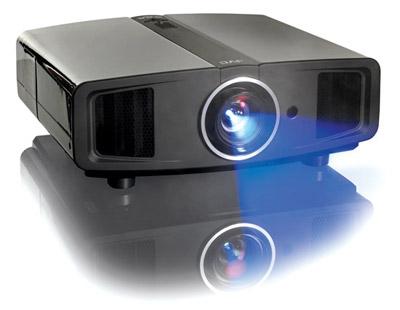JVC Lets Loose Another Top-Notch Projector

 JVC has long been a player in industrial-grade video front projectors, with its D-ILA (JVC's variant of LCoS technology) models finding their way into plenty of boardrooms, digital movie theaters, and other commercial venues. But in late 2006 the company also made a big splash in the consumer market with the introduction of its then $6,300 DLA-HD1 - a 1080p-rez model that got an enthusiastic reception in this magazine (reviewed May 2007). The DLA-HD1 was an easy candidate for my 2007 Editor's Choice list of the year's best products. That is, until it got unceremoniously bumped at the last minute by JVC newest D-ILA projector, the DLA-HD100.
JVC has long been a player in industrial-grade video front projectors, with its D-ILA (JVC's variant of LCoS technology) models finding their way into plenty of boardrooms, digital movie theaters, and other commercial venues. But in late 2006 the company also made a big splash in the consumer market with the introduction of its then $6,300 DLA-HD1 - a 1080p-rez model that got an enthusiastic reception in this magazine (reviewed May 2007). The DLA-HD1 was an easy candidate for my 2007 Editor's Choice list of the year's best products. That is, until it got unceremoniously bumped at the last minute by JVC newest D-ILA projector, the DLA-HD100.
The Short Form |
| Price: $7,999 / jvc.com / 800-252-5722 |
Snapshot |
| JVC's successor to its standout DLA-HD1 costs more money, but on several fronts it's a better front projector. |
Plus |
| •Crisp high-def picture •Exceptionally punchy contrast •Accurate out-of-box performance •Low fan noise |
Minus |
| •Colors can look overly vivid •Limited aspect ratio control for HDTV programs •No VGA input |
Key Features |
| •1080p resolution •2.0x zoom lens •Accepts 1080p/24 input signals •Motorized zoom, focus, and lens shift •Custom global and R,G, and B gamma adjustments •V-stretch display mode for 2.35:1 screens •200-watt UHP lamp •Inputs: 2 HDMI, component-, composite-, and S-video; RS-232C •18 x 7 x 16.5 IN / 25.5 LBS |
At $8,000, the DLA-HD100 commands a sizeable price premium over its predecessor. Looking over the projector and its spec sheet, that price jump caused me to wonder: the HD100's physical dimensions and weight are the same, as are its 200-watt lamp, 2.0x zoom lens, and high-performance Gennum video processor. Come to think of it, lots of things about this projector are the same as last year's HD1, with the exception of its powered lens controls, HDMI 1.3 inputs, and V-Stretch (Vertical Stretch) display mode, which lets you pair the projector with an ultra-wide 2.35:1 screen without shelling out extra for an outboard video processor. And then there's one key performance spec that we'll get to shortly. All in all, that's a good-size list of improvements, but is it worth the extra money?
At 25 pounds, the HD100 is fairly hefty by today's lightweight standards. However, the all-black case and whisper-quiet fan lend it a stealthy quality - mount it on the ceiling and you'll barely notice the projector is there. A basic set of control buttons for switching inputs and navigating onscreen menus is located on the top half of the case. The JVC's manual lens shift gives you a wide offset range (34% horizontal and 80% vertical from the center of the projected image), which helps to make initial setup a snap. And once that's been completed, the powered zoom and focus controls let you dial in those lens settings via remote control. As with the HD1, there JVC eschews any manual or automatic iris controls to pump up perceived picture contrast: what you see is what you get. You do get a choice of Normal or High lamp power modes, however. These settings affect the overall brightness of the image, with High being the choice for brighter rooms and Normal for a light-controlled home theater. According to JVC's manual, opting for the High mode won't shorten the projector's specified 2,000-hour lamp life.
Inputs on the JVC include two HDMI ports and component-, composite-, and S-video jacks. Unfortunately, there's no DVI or VGA input for PC hookups - a standard feature on most other front projectors. On the plus side, JVC's remote control has basically every control button you could wish for laid out on its surface. The keypad is also fully backlit, which is something I always like to see in a front projector remote. The controls are clustered logically: direct input buttons for switching video sources at top; a set of buttons to select various Image Profiles (picture presets) directly beneath; and controls to directly tweak color, contrast, and brightness (as well as switch between gamma and color temperature presets), one step further down. Once I had finished my initial setup, the easy access to direct picture adjustments afforded by the remote's keypad meant I barely had to revisit onscreen menus.
You switch display modes (aspect ratios) on the JVC by hitting the Aspect button. With standard-definition (480i- and 480p-format) programs, you can choose between 4:3, 16:9, and a Zoom mode that blows up standard 4:3 images to fill a 16:9 aspect ratio screen. With high-definition programs, the JVC's aspect ratio modes are limited to 16:9 display (a specialized V-Stretch option is also available when using the projector with an anamorphic lens and an ultra-wide 2.35: 1 aspect ratio projection screen).
- Log in or register to post comments









































